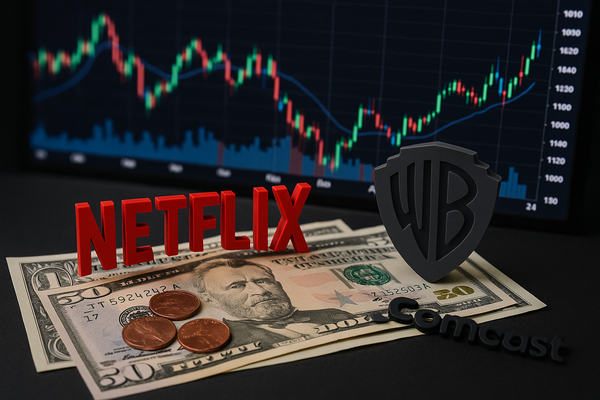
Comcast, Netflix and Fox set the tape this week with a mix of M&A noise, distribution fights and ad strength that matters now for trading flows and relative valuations. Netflix’s 10-for-1 split and reports it has tapped advisers to explore Warner Bros options accelerate takeover optionality in the near term. Comcast beat earnings but lost 104,000 broadband subscribers, renewing pressure on cable multiples. Fox’s advertising beat and buyback plan show how ad-led cash flow is being redeployed. Short-term, headlines drive volatility. Long-term, content ownership, distribution fees and ad monetization will determine winners across the globe.
Streaming M&A and Content Ownership: Netflix’s optionality re-enters the market
Netflix’s stock split and reports it has engaged Moelis to explore a bid for Warner Bros refocus attention on consolidation among global studios. The split makes shares more tradable for employees and retail holders. Separately, Warner Bros is back on many boards’ radars because owning a library would deepen Netflix’s control over content licensing and reduce its dependence on external studios.
Why this matters now: financing conditions remain favorable for large strategic deals but are sensitive to yields and leverage costs. A move by Netflix would force competitors and studios to re-evaluate balance sheets and strategic plans in the near term. Over the longer term, more integrated content owners can capture advertising, licensing and distribution margins across territories, pressuring independent streamers and raising the bar for new entrants.
Advertising and Monetization: Fox, Roku and Reddit show ad demand is uneven but resilient
Fox posted stronger-than-expected results with revenue of $3.74 billion and adjusted earnings of $1.51 per share, beating consensus by a wide margin on profitability. The company also reported record quarterly advertising revenue of $1.4 billion, up 6% year on year, and launched a $1.5 billion buyback program. Those moves highlight how legacy broadcasters are monetizing both linear and FAST platforms.
Roku delivered a solid platform quarter, reporting $1.21 billion in revenue, up 14% year on year, and posted its first operating profit since 2021. Yet shares fell after investors focused on device weakness. Reddit, which reported 68% revenue growth and a sizable beat, underscores how targeted, AI-driven ad products can lift CPMs and advertiser demand across formats.
Macro link: advertising budgets are tied to consumer spending and macro growth. If the US and European ad markets hold up, ad-centric businesses with strong measurement and programmatic stacks will re-rate. However, any slowdown in ad spend or a shift of dollars to large tech platforms can compress margins for smaller publishers and FAST services.
Distribution, Broadband and Platform Risk: Comcast, Disney and Roku illustrate competing pressures
Comcast beat headline earnings and revenue with modest upside to estimates. Still, it reported a loss of 104,000 domestic broadband subscribers, its tenth straight quarterly decline, leaving the company with roughly 31.4 million broadband customers. Theme parks were a bright spot: attractions revenue, led by the new Epic Universe, climbed 18.7% and contributed $2.7 billion.
Distribution friction also surfaced when Disney channels were removed from YouTube TV after the two sides failed to agree on new carriage terms. That dispute is a reminder that retransmission and streaming carriage negotiations can be abrupt and that distribution partners can influence short-term revenue and viewership metrics.
Roku’s mix issue illustrates platform risk. The company’s ad business is strengthening, but softer device sales and the programmatic supply chain’s fraud concerns add execution risk. Together, these stories show how platform owners must balance subscriber economics, distribution deals and hardware economics while facing competition from Big Tech and shifting consumer viewing patterns.
Investor Reaction: rotation, profit-taking and reprice of exposure
Trading behavior this week reflected differentiated responses across the group. Fox shares jumped more than 6% intraday after the earnings beat and commentary. Netflix rose in extended hours after the stock split announcement, adding to the company’s M&A optionality thesis. Conversely, Comcast shares remain under pressure, trading down significantly year to date as investors price persistent broadband declines into valuations.
Roku experienced an intraday selloff despite beating on the top and bottom line, driven by focus on device revenue and margin cadence. Sirius XM spiked after beating revenue and profit expectations, demonstrating investor appetite for stable subscriber cash flow in a higher-rate environment. Volume spikes around these events point to short-term speculative flows as well as institutional rotation into ad-friendly assets and away from legacy broadband exposure.
What to Watch Next
- Netflix and Warner Bros developments. Any formal bid process, exclusivity period or break-fee details will be catalysts that move both owners and distributors globally.
- Comcast commentary on broadband trends and guidance. Watch subscriber trends, wireless ramp and commentary on competitive home-internet offers from mobile carriers.
- Roku’s next-quarter guidance and programmatic ad quality metrics. Look for signs that platform monetization offsets device softness.
- Disney and YouTube TV negotiations. Outcomes affect short-term distribution revenue and could influence retransmission dynamics across other MVPDs and vMVPDs in the US and Europe.
- Advertising macro updates. Macro data on consumer demand and key retail ad buyers’ bookings will shape ad revenue outlooks for Fox, Roku, Reddit and streaming ad tiers.
- Financing markets and yields. Large potential deals will be sensitive to credit spreads and long-term yield levels. Watch corporate bond issuance and secondary market pricing for clues on deal feasibility.
Scenario planning for the coming month: If Netflix advances acquisition steps, expect upward repricing for major content owners and renewed M&A chatter. If Comcast’s broadband outflows persist, multiple compression may continue for cable incumbents while ad-centric publishers and FAST platforms find relative favor. Distribution disputes that resolve quickly could be neutral to favorable for incumbents; protracted negotiations would add near-term risk to subscriber-based revenue lines.
Data and context in this report come from recent company releases, earnings-call highlights and market coverage. This is informational market commentary and not investment advice. Monitor the catalysts above for how they alter relative value across the group and which names show durable monetization versus transitory headline moves.












